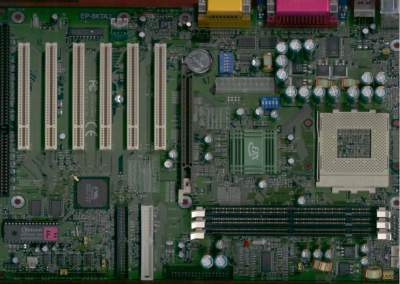EPoX EP-8KTA2 Socket-A KT133 (686B) ATX
by Henry Kuo on November 14, 2000 12:00 PM EST- Posted in
- Motherboards
The VIA KT133 chipset has helped AMD in support their Socket-A series of processors since their launch about five months ago. Back in August, during our KT133 roundup, the ASUS A7V and the ABIT KT7 stood out from the pack of eleven boards thanks to their ability to change the multiplier ratios of the processors, Ultra ATA 100 support, and rock solid performances.
We're just now starting to see the second wave of KT133 boards become available, and suddenly the market has become much more competitive. Feature wise, the method to implement multiplier ratio settings are no longer secret, the VIA 686B South Bridge is ready to support Ultra ATA 100, and IDE RAID controllers have become more and more common. In terms of design, five months is quite long in this fast paced market, allowing manufactures to increase both the performance and stability of their motherboards through more careful routing of traces or the inclusion of higher quality components. Price wise, manufacturers have been constantly lowering prices because of higher competition and simple economies of scale as production has increased. This is all good news for the customer, who is always looking for better performance at a lower price.
EPoX had some of the first and the best VIA based Super7 solutions back during the reign of the K6-2 and K6-III as AMD’s flagship CPUs. They also carry a decent Slot-A motherboard, the EP-7KXA. Now, during the second KT133 wave, it is definitely time for EPoX to release their newest KT133 motherboard, the EP-8KTA2. Let's take a look at what EPoX has done with the EP-8KTA2 to make it a good contender in that competitive KT133 market.
|
EPoX EP-8KTA2 Specifications |
|
| CPU Interface |
Socket-A
|
| Chipset |
VIA
KT133
VIA 8263 North Bridge VIA 686B Super South Bridge |
| L2 Cache |
N/A
(on-chip)
|
| Form Factor |
ATX
|
| Bus Speeds |
95
/ 100 / 102 / 104 / 106 / 107 / 108 / 109 / 110
111 / 112 / 113 / 114 / 116 / 118 / 120 / 124 / 127 130 / 133 / 136 / 140 / 145 / 150 / 155 / 160 / 166 |
| Voltages Supported |
Auto
Detect
1.475 - 1.850 V (in 0.025V increments) |
| Memory Slots |
3
168-pin DIMM Slots
|
| Expansion Slots |
1 AGP Slot
6 PCI Slots (2 Full Length) 1 ISA Slot (1 Shared) 0 AMR Slots |
| Onboard Sound |
VIA
VT1611A AC 97 CODEC
|
| BIOS |
Award
Modular BIOS 6.00PG
|
The Good
Compared to most KT133 motherboards, EPoX actually uses a smaller PCB, measuring approximately 12 by 9 inches. This is good news since a smaller PCB means lower production costs, which is definitely shown in the retail price of the board. It also means fewer problems for users with smaller cases. The small size of PCB shows that EPoX did took the effort to reroute some of the traces, both to reduce the space and possibly to increase performance and stability.
The power supply connector is placed close to the serial / parallel connector, and right next to some capacitors and dipswitches. This means the power cables will have to run over the CPU and the memory, potentially blocking the airflow around the CPU socket. So far, the best places for the power supply connector are the right edge of the board or next to the DIMM slots. That way the cables will not have to run over the CPU. However, based on the fact that we do not see many boards using such a layout, it is quite possible that manufacturers are having difficulty routing the traces this way, especially with a smaller PCB, like that found on the EP-8KTA2.











0 Comments
View All Comments